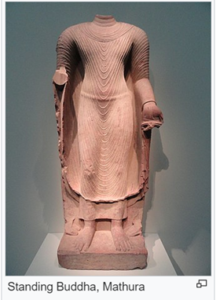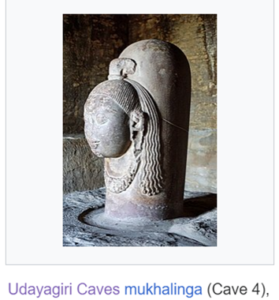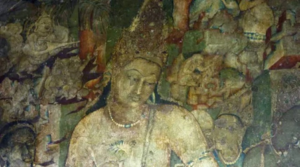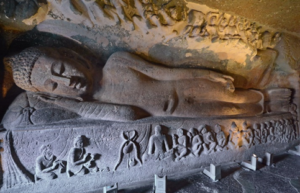CSIP: PRELIMS BOOSTER SERIES -488 ART AND CULTURE
GUPTA ART
WHY IN NEWS?
Times of India: Excavations discover Gupta age coins.
BACKGROUND
Gupta was a dyntasy that ruled northern India during 300 AD -600AD
TEMPLES
Gupta period marked the formative phase in temple construction in northern India.
1.DASHAVATAR TEMPLE (Deogarh UP)

2..UDAYAGIRI CAVE TEMPLE (Vidisha, MP)
- Primarily devoted Vishnu and Shiva
- Group of 20 rock cut caves with Hindu iconography (only 1 cave has Jain iconography)
- Contains Famous sculptural panel: Vishnu in Varaha avatar lifting Bhudevi


SCULPTURES
Though sculptures of Buddha and Jain tirthankaras began to be made since the post Mauryan times, it attained its peak during the Gupta era. The renowned Gupta sculptural style appears to have grown out of the Kushan style.
In addition to Buddhist and Jain iconography , Brahmanical images like Shiva, Vishnu, Durga also became prominent.
EXAMPLES




PAINTINGS
Painting in the Gupta era struck a new line of development like never before. The glory and splendour of Gupta painting is unmatched in ancient Indian history.
The examples of paintings can be found from Ajanta caves(Mahrashtra), Bagh caves(Group of 9 Buddhist caves at Dhar M.P)
AJANTA CAVES

- The caves(around 30), cut into the face of a mountain, form a horseshoe shape around the Wangorah River.
- All of the caves at Ajanta fall into the category of Vihara (monasterieswith residence halls), or Chaitya-grihas (sanctuaries/stupa monument halls).
- Constructed in phases: 1. Under Satavahannas and 2. Under Guptas
- The caves contain murals, wall paintings and scultpures relating to Buddhist tradition
Padmani Buddha painting

Reclining Buddha

LITERATURE
What we refer to as “Classical Sanskrit” developed during the Guptas. The zealous patronage of Gupta kings to Sanskrit led to an all-encompassing expansion of Sanskrit literature.
EXAMPLES
- Religious literature in the form of Smritis, Puranas and Shastras.
- Kalidasa: AbhijnanaShakuntalam, Malavikagnimitram, Vikramorvashiyam and poetic works such as Raghuvamsham, Ritusamhaara, Kumarasambhavam and Meghadutam
- Vishakadatta: Mudrarakhshasa and Devichandraguptam
- Amarasimha: Sanskrit dictionary Amarakosha
- Vatsyayna: Kamasutra
- Bhasa (predecessor of Kalidasa placed around 1 BCE- 4 CE) father of Sanskrit drama authored 13 plays (eg daridracharudatha)
SCIENCE
1.Varamihira (Ujjain 6th CE):
Works: (Astrology and Astronomy)
Pancha Siddhanta: treatises on 5 astronomical theories (Surya Siddhanta, Romaka siddhanta) .
Used the decimal notation with its place-value number system, Arithmetic addition and subtraction operations involving zero
Brahat Samhita: deals with astronomy, astrology, botany, natural history and physical geography
horoscopy – Laghu-Jataka and Brihaj-Jataka
2.Aryabhatta (Pataliputra, 476-550)
Works: (Astronomy and mathematics)
Arybhatiya, Surya Siddhanta : Concepts:
Heliocentrism
Explanation for eclipses
Use of Place value system and zero
Approximation of the value of pi
Trignometry: 1st to evolve sine functions
Concepts on mensuration algebraic equations etc.
Explanation and description of motion of planets, sun , moon etc.

